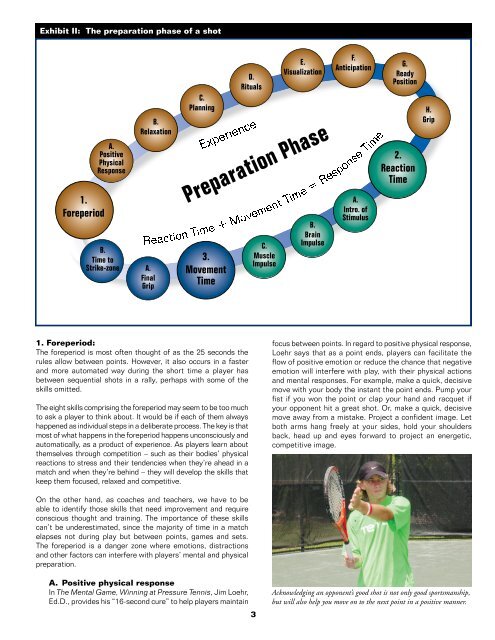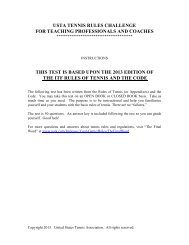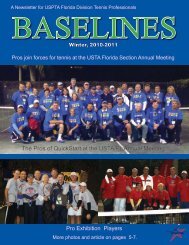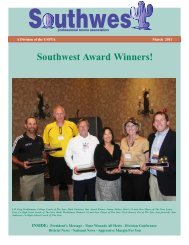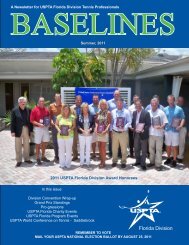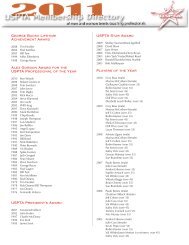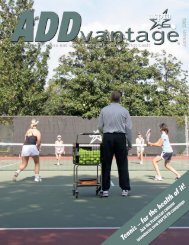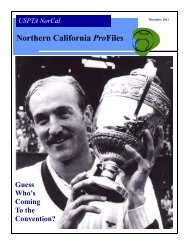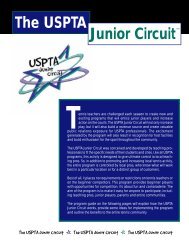Volume 2, No. 3 - United States Professional Tennis Association
Volume 2, No. 3 - United States Professional Tennis Association
Volume 2, No. 3 - United States Professional Tennis Association
Create successful ePaper yourself
Turn your PDF publications into a flip-book with our unique Google optimized e-Paper software.
Exhibit II: The preparation phase of a shot<br />
1.<br />
Foreperiod<br />
A.<br />
Positive<br />
Physical<br />
Response<br />
B.<br />
Time to<br />
Strike-zone<br />
B.<br />
Relaxation<br />
Experience<br />
Reaction Time + Movement Time = Response Time<br />
A.<br />
Final<br />
Grip<br />
C.<br />
Planning<br />
3.<br />
Movement<br />
Time<br />
D.<br />
Rituals<br />
C.<br />
Muscle<br />
Impulse<br />
E.<br />
Visualization<br />
Preparation Phase<br />
B.<br />
Brain<br />
Impulse<br />
F.<br />
Anticipation<br />
A.<br />
Intro. of<br />
Stimulus<br />
G.<br />
Ready<br />
Position<br />
2.<br />
Reaction<br />
Time<br />
H.<br />
Grip<br />
1. Foreperiod:<br />
The foreperiod is most often thought of as the 25 seconds the<br />
rules allow between points. However, it also occurs in a faster<br />
and more automated way during the short time a player has<br />
between sequential shots in a rally, perhaps with some of the<br />
skills omitted.<br />
The eight skills comprising the foreperiod may seem to be too much<br />
to ask a player to think about. It would be if each of them always<br />
happened as individual steps in a deliberate process. The key is that<br />
most of what happens in the foreperiod happens unconsciously and<br />
automatically, as a product of experience. As players learn about<br />
themselves through competition – such as their bodies’ physical<br />
reactions to stress and their tendencies when they’re ahead in a<br />
match and when they’re behind – they will develop the skills that<br />
keep them focused, relaxed and competitive.<br />
focus between points. In regard to positive physical response,<br />
Loehr says that as a point ends, players can facilitate the<br />
flow of positive emotion or reduce the chance that negative<br />
emotion will interfere with play, with their physical actions<br />
and mental responses. For example, make a quick, decisive<br />
move with your body the instant the point ends. Pump your<br />
fist if you won the point or clap your hand and racquet if<br />
your opponent hit a great shot. Or, make a quick, decisive<br />
move away from a mistake. Project a confident image. Let<br />
both arms hang freely at your sides, hold your shoulders<br />
back, head up and eyes forward to project an energetic,<br />
competitive image.<br />
On the other hand, as coaches and teachers, we have to be<br />
able to identify those skills that need improvement and require<br />
conscious thought and training. The importance of these skills<br />
can’t be underestimated, since the majority of time in a match<br />
elapses not during play but between points, games and sets.<br />
The foreperiod is a danger zone where emotions, distractions<br />
and other factors can interfere with players’ mental and physical<br />
preparation.<br />
A. Positive physical response<br />
In The Mental Game, Winning at Pressure <strong>Tennis</strong>, Jim Loehr,<br />
Ed.D., provides his “16-second cure” to help players maintain<br />
3<br />
Acknowledging an opponent’s good shot is not only good sportsmanship,<br />
but will also help you move on to the next point in a positive manner.


